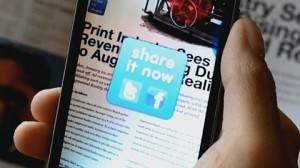By Doug Stephens
It’s been almost a year ago that I spoke with Maarten Lens-Fitzgerald, one of the co-founders of Layar and a pioneer in the development of augmented reality or “A/R” applications. At that time we were discussing the potential for a battle between brands over virtual real estate as companies awaken to the opportunity to create augmented reality stores in high traffic public places, such as Nike’s installation in New York.
Maarten’s passion and excitement about A/R was palpable and we had a great conversation about its future. Like many others, I saw tremendous possibilities for the technology to manifest itself in cutting edge consumer experiences. This melding of the physical and the virtual seemed to me to be a marketer’s dream.
A/R had a long way to go…
I was also not alone however, in the belief that A/R had a long way to go. While companies like Nike and Lego were clearly experimenting with the technology, there simply weren’t enough public A/R installations or applications out there to generate consumer awareness of the technology or where to find it – much less how to use it. Even the marketing community was generally unaware of what augmented reality was. Furthermore, the technology itself was a little rough around the edges. Graphics and animation tended not to be extremely clear or crisp making for an often-disappointing overall experience. Above all, the big question about A/R was one of utility. Sure, it was cool but was it useful especially compared to other, more developed and trusted mediums such as QR (quick response) codes?
A giant step towards mainstream
This week Layar (and augmented reality in general) took a quantum step forward in satisfying skeptics with an innovation called Layar Vision. Essentially, Layar Vision is a new system protocol that enables recognition of everyday objects, , overlaying them with digital content- similar to Google Goggles. It also works much like QR code technology does but in this case, the object itself acts as the code. Just scan the object using the Layar app and you’ll immediately be able to see the digital content attached to it.
Magazines, books, food packages, cars or any other object can be recognizable to the program and instantly overlay it with digital information which the user can then interact with. The conceivable applications for it are limitless.
I think you’ll agree after watching the video below that with this single innovation, it’s my feeling that we’ve seen A/R go from being a novelty to something many marketers could find practical applications for. It certainly takes A/R off the marketing fringe and puts it in a similar arena with QR and NFC technology.
[youtube]http://www.youtube.com/watch?v=AsD0DuPT1GI&feature=player_embedded#at=25[/youtube]

